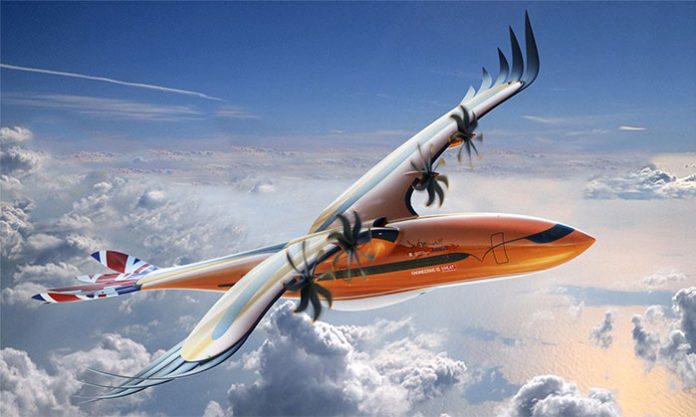
In recent times, the aviation industry has come under heavy scrutiny from environmental activists. Although airplanes contribute an estimated 2% of global greenhouse gas emissions, there are still concerns that the industry is not doing enough to make flying more sustainable. The bird of prey concept plane recently unveiled by European Airplane Manufacturers, Airbus, reveals a bold attempt to address some of the sustainability issues facing the aviation industry. The project takes a cue from biomimicry– the design and production of materials that are modeled on biological entities and processes.
Design and features
To be honest, the concept plane unveiled is unlike anything the aviation industry has ever seen. Virtually everything about the plane is atypical; from the feathered wings and rudder to the conspicuous multiple propellers, and the general shape of the aircraft. According to Airbus spokespersons, the concept is inspired by the mechanics of birds of prey, with the designers drawing inspiration from hawks, eagle, and some other flying predators.
Feather-like wings and rudder
The Bird of Prey’s wings and rudder are equipped with individually-controlled feather-like tips. Such a design concept would hopefully help minimize drag while making the plane easier to control. Another intriguing feature of the wings is the smooth wing root. This is the point of fusion of the wings and fuselage and it inspired by the aerodynamic arch of the eagle. Moreover, the smooth wing root will likely make maneuvering easier.
Advanced propulsion system
The propulsion system draws from an advanced propulsion technology that is currently under development. Airbus claims that with this system, the Bird of Prey would consume 30-50% less fuel than the conventional. This would represent much-desired progress in the field of fuel efficiency in the aviation industry.
Hybrid-electric design
A mammoth amount of energy is required to propel an airplane, and that is a major hindrance when it comes to designing electric airplanes. Today’s batteries cannot store enough energy to lift an airplane off the ground. On a weight basis, jet fuel provides more than 40 times more energy units than a battery of equivalent weight. Burdening an airplane with an ultra-heavy battery would only complicate the problem. The Bird of Prey attempts to marry both worlds with its hybrid-electric design. The argument is that, with biomimicry, the energy required to propel planes would reduce significantly and batteries would be able to provide some of the required energy.
Not more than a concept
Unfortunately, Airbus announced that they do not have plans to take the Bird of Prey concept into the workshop. The design, although realistic, is only aimed at providing an insight into possible interventions that could help us produce the planes we dream of. In the words of Martin Aston, a senior manager at Airbus, “Our Bird of Prey is designed to be an inspiration to young people and create a ‘wow’ factor that will help them consider an exciting career in the crucially important aerospace sector.”
It’s hard to argue that the aviation industry is in dire need of novel ideas in the coming future. If shaping planes like birds is what it takes to get them to consume less fuel and make less noise, we might as well get to work immediately.

Startup
A startup or start-up is a company or project undertaken by an entrepreneur to seek, develop, and validate a scalable business model. While entrepreneurship refers to all new businesses, including self-employment and businesses that never intend to become registered, startups refer to new businesses that intend to grow large beyond the solo founder. At the beginning, startups face high uncertainty and have high rates of failure, but a minority of them do go on to be successful and influential. Some startups become unicorns; that is privately held startup companies valued at over US$1 billion.
Actions
Startups typically begin by a founder (solo-founder) or co-founders who have a way to solve a problem. The founder of a startup will begin market validation by problem interview, solution interview, and building a minimum viable product (MVP), i.e. a prototype, to develop and validate their business models. The startup process can take a long period of time (by some estimates, three years or longer), and hence sustaining effort is required. Over the long term, sustaining effort is especially challenging because of the high failure rates and uncertain outcomes. Having a business plan in place outlines what to do and how to plan and achieve an idea in the future. Typically, these plans outline the first 3 to 5 years of your business strategy.
Design principles
Models behind startups presenting as ventures are usually associated with design science. Design science uses design principles considered to be a coherent set of normative ideas and propositions to design and construct the company's backbone. For example, one of the initial design principles is "affordable loss".
- Log in to post comments